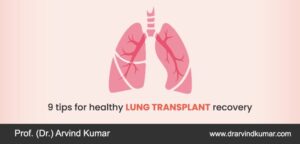A lung transplant is one of a number of options for end-stage lung disease. However, a lung transplant procedure is not ideal for everyone. A lung transplant is suitable only when all other alternative treatments are unsuccessful.
A lung transplant is a surgical procedure to replace a failing lung with a healthy lung from a donor. People with end-stage lung disease can no longer experience positive results with medical therapies. In India, the success rate of lung transplants is improving gradually with the advancement of technology.
Based on your medical condition, the procedure may involve replacing one or both lungs. Lung transplants are suitable for people of all ages, from newborns to adults. Here are some essential aspects to know about the success rate of lung transplants in India.
Types of Lung Transplants in India
Here are the four different types of lung transplants in India.
-
Single Lung Transplant
In this procedure, the doctor will remove one of your lungs and replace it with a donated lung.
-
Double Lung Transplant
Your doctor will remove both lungs and replace them with the donor’s lungs.
-
Bilateral Sequential Transplant
It is the transplant of both lungs, done one at a time.
-
Heart-Lung Transplant
It involves transplanting both the heart and lungs from a single donor.
Success Rate of Lung Transplant in India
India is witnessing rapid growth in the field of lung transplants. Thanks to advanced healthcare measures, organ transplants in India are highly successful. As a result, 70% to 85% of patients who underwent the lung transplant procedure were satisfied with the procedure.
Approximately 80% of patients experienced an increased lifespan of one year. On the other hand, 50% of patients increased life expectancy to 5 years after the procedure.
Factors Responsible for the Success of Lung Transplants in India
Lung transplantation has come of age in India. Here are the factors responsible for the success of lung transplants in India.
Medical Advancements
Medical advancements are pioneering lung transplants in India. Nowadays, people with end-stage lung disease can enjoy a longer life expectancy rate after the procedure. Healthcare interventions with progressive improvement in antirejection drugs are making lung transplants successful.
Patients can now enjoy an uncomplicated recovery stage after the surgery. Here are some other medical advancements contributing to the success of lung transplants in India.
- Nowadays, healthcare facilities have better intensive care monitoring technologies. For instance, many hospitals have cardiac output monitors that measure the quantity of blood pumped by the heart.
- The integration of pulse oximeters in ICUs is assisting in better recovery of lung transplant patients. Pulse oximeters can measure oxygen levels accurately.
- Hospitals have blood gas machines to measure oxygen levels, carbon dioxide and your blood’s acidic and alkaline levels.
Progress of Healthcare Technology in India
In most lung transplants in India, doctors use polypropylene sutures. These types of sutures are inert and don’t cause any harmful reaction in the body. With the advancements in healthcare technology, surgeons can adjust the lung to fit into your chest cavity.
Moreover, surgeons leverage titanium staplers for better preservation of blood supply to the lungs. With these advancements, patients undergoing double lung transplants can survive for more than five years.
Drastic Advancements in Surgical Procedures
Another reason behind the success of lung transplants in India is advancements in surgical procedures. Surgeons leverage extracorporeal oxygenation membrane during the transplantation procedure. Known as artificial lungs, it helps maintain proper oxygen levels when the transplanted lungs are recovering.
An extracorporeal oxygenation membrane can help maintain proper oxygen levels even during lung failure. Furthermore, healthcare facilities have access to better preservative solutions to store donated lungs. For example, healthcare facilities nowadays use Perfedex to preserve donated lungs.
The Emergence of Air Ambulances
The emergence of air ambulances is another factor responsible for the success of lung transplants in India. Nowadays, healthcare facilities can swiftly transport donated lungs to transplantation centres. Even patients across India can be airlifted via air ambulances to the transplant centres.
Steady Progress in Recovery Rate
Patients undergoing lung transplants can now experience a faster recovery. Improved recovery rate after lung transplant results from improved surgical methods and customised post-operative care. All these factors contribute to the faster recovery of patients who undergo lung transplantation.
Significance of Critical Care after Lung Transplant
The recent success of lung transplants in India is mainly due to the collaborative approach between healthcare specialists. After undergoing a lung transplant, you will start to feel stronger. The end goal is to allow you to breathe freely without oxygen support.
The first few months after the transplant are critical to your overall health. It is essential to adhere to the aftercare instructions provided by the surgeon. Normally, after a lung transplant, patients need to stay in the healthcare facility after a lung transplant. During your stay, the healthcare provider will make you practice breathing exercises. You will learn how to use an incentive spirometer to practice breathing exercises.
Preventing Lung Transplant Complications and Rejection
After the transplant, a lung biopsy is a preferred method for doctors to know whether your body is accepting the new lung. In the initial few months after the transplant, you will have to undergo various types of tests.
Some of them are as follows:
- Chest X-Rays
- Clinic visits
- Bronchoscopy with biopsy
- Pulmonary function tests
You will have to take the antirejection drugs for the rest of your life after the transplant. Regular visits to the clinic are imperative for a good recovery. During these visits, your doctor will continuously monitor how you respond to medications. Here are some ways in which you can make the lung transplant procedure successful.
- Take all medications as recommended by the doctor
- Adhere to the diet plan
- Avoid products containing nicotine
- Practice breathing exercises regularly
If you are an ideal candidate for a lung transplant, consult with Dr Arvind Kumar. Dr Arvind Kumar has more than forty years of clinical experience. He possesses more than two decades of experience performing keyhole and robotic surgeries.

.webp)



